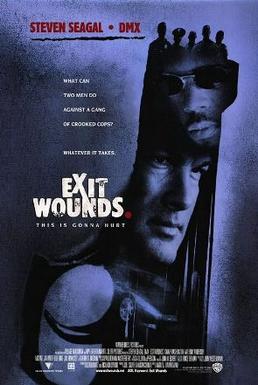
Exit Wounds is a 2001 American action film directed by Andrzej Bartkowiak, and starring Steven Seagal and DMX. The film is based on the book of the same name by John Westermann. The book takes place on Long Island, while the film is set in Detroit. Steven Seagal plays Orin Boyd, a police detective notorious for pushing the limits of the law in his quest for justice.
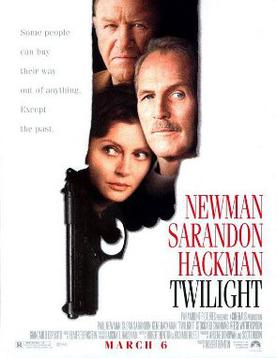
Twilight is a 1998 American neo-noir thriller film directed by Robert Benton, written by Benton and Richard Russo, and starring Paul Newman, Susan Sarandon, Gene Hackman, Reese Witherspoon, Stockard Channing, and James Garner. The film's original score was composed by Elmer Bernstein.
A scène à faire is a scene in a book or film which is almost obligatory for a book or film in that genre. In the U.S. it also refers to a principle in copyright law in which certain elements of a creative work are held to be not protected when they are mandated by or customary to the genre.
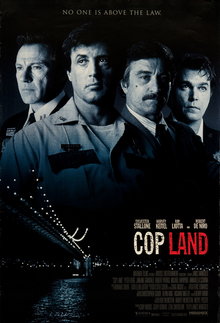
Cop Land is a 1997 American neo-noir crime drama film written and directed by James Mangold. It stars an ensemble cast that includes Sylvester Stallone, Harvey Keitel, Ray Liotta, and Robert De Niro, with Peter Berg, Janeane Garofalo, Robert Patrick, Michael Rapaport, Annabella Sciorra, Noah Emmerich, and Cathy Moriarty in supporting roles. Stallone portrays the sheriff of a small New Jersey town who comes into conflict with the corrupt New York City police officers living in the community. The film received positive reviews and grossed $63.7 million on a $15 million budget.

Strike Force is an American action-adventure/police procedural television series that aired on ABC during the 1981–1982 television season, and was produced by Aaron Spelling Productions. The program starred Robert Stack as Capt. Frank Murphy, the leader of a specialized unit of detectives and police officers whose job is to stop violent criminals at any cost.
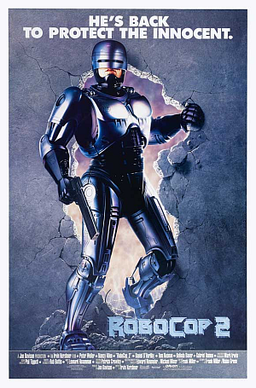
RoboCop 2 is a 1990 American science fiction action film directed by Irvin Kershner and written by Frank Miller and Walon Green. It stars Peter Weller, Nancy Allen, Dan O'Herlihy, Belinda Bauer, Tom Noonan and Gabriel Damon. It is the sequel to the 1987 film RoboCop, the second entry in the RoboCop franchise and the last to feature Weller as RoboCop until he returned in Mortal Kombat 11, RoboCop: Rogue City and other media; it is also the last film Kershner directed before his death in 2010.
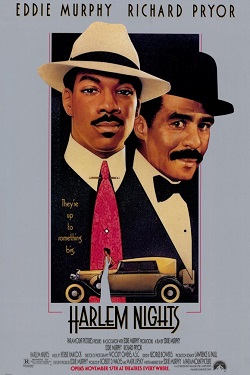
Harlem Nights is a 1989 American crime comedy-drama film starring, written, and directed by Eddie Murphy. The film co-stars Richard Pryor, Redd Foxx, Danny Aiello, Michael Lerner, Della Reese, and Murphy's older brother Charlie. The film was released theatrically on November 17, 1989, by Paramount Pictures. The film tells the story of "Sugar" Ray and Vernest "Quick" Brown as a team running a nightclub in the late 1930s in Harlem while contending with gangsters and corrupt police officials.
Rachel Ticotin Strauss is an American film and television actress. She has appeared in films such as Fort Apache, The Bronx, Total Recall, Falling Down, and Con Air. She has appeared in the NBC legal drama Law & Order: LA as Lt. Arleen Gonzales, and guest starred in the "Warriors" episode of Blue Bloods in 2013, appearing as "Carmen Castillo".

Wolfen is a 1981 American crime horror film directed by Michael Wadleigh in his only directional feature film, based on Whitley Strieber's 1978 novel The Wolfen. It stars Albert Finney, Diane Venora, Gregory Hines and Edward James Olmos. The film follows a city cop who has been assigned to uncover what is behind a series of vicious murders. Originally, it is believed the murders are animal attacks until the cop discovers an indigenous legend about wolf spirits.

Homicide is a 1991 American crime drama film written and directed by David Mamet. The film's cast includes Joe Mantegna, William H. Macy, and Ving Rhames. It was entered in the 1991 Cannes Film Festival.
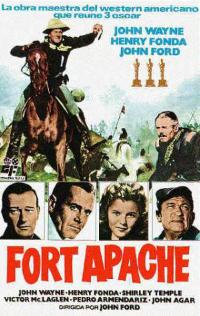
Fort Apache is a 1948 American Western film directed by John Ford and starring John Wayne and Henry Fonda. The film was the first of the director's "Cavalry Trilogy" and was followed by She Wore a Yellow Ribbon (1949) and Rio Grande (1950), both also starring Wayne. The screenplay was inspired by James Warner Bellah's short story "Massacre" (1947). The historical sources for "Massacre" have been attributed both to George Armstrong Custer and the Battle of Little Bighorn and to the Fetterman Fight.

Final Examination is a 2003 American erotic horror thriller film which was directed by Fred Olen Ray and stars Kari Wührer, Brent Huff and Debbie Rochon.

The Super Cops is a 1974 action adventure film directed by Gordon Parks and starring Ron Leibman and David Selby. The film is based on the book The Super Cops: The True Story of the Cops Called Batman and Robin by L. H. Whittemore. The film was released a few months after the successful cop movie Serpico.

Fort Apache is, metaphorically, a building, complex, or defensive site providing shelter from hostile action in the form of crime or native insurrection or enemy attack.
The Police Tapes is a 1977 documentary about a New York City police precinct in the South Bronx. The original ran ninety minutes and was produced for public television; a one-hour version later aired on ABC.

Fuzz is a 1972 American action comedy film directed by Richard A. Colla and starring Burt Reynolds, Yul Brynner, Raquel Welch, Tom Skerritt and Jack Weston.

Throughout the history of the New York City Police Department, numerous instances of corruption, misconduct, and other allegations of such, have occurred. Over 12,000 cases have resulted in lawsuit settlements totaling over $400 million during a five-year period ending in 2014. In 2019, misconduct lawsuits cost the taxpayer $68,688,423, a 76 percent increase over the previous year, including about $10 million paid out to two exonerated individuals who had been falsely convicted and imprisoned.

Yellow Faced Tiger is a 1974 Hong Kong-American martial arts action film directed by Lo Wei, and starring Wong Tao, Sylvia Chang and Chuck Norris.
Randy Jurgensen is a former American NYPD detective, best known as the lead investigator into the murder of patrolman Phil Cardillo as well as his contribution as a consultant on various film and TV projects.















